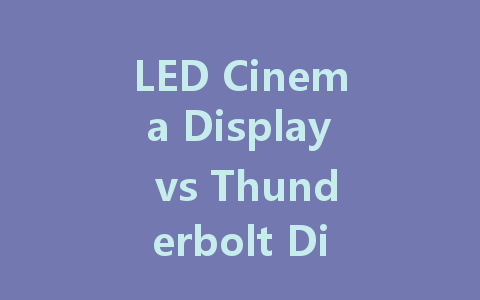
When it comes to monitors, Apple’s LED Cinema Display and Thunderbolt Display have been popular choices for creative professionals and tech enthusiasts alike. Both displays offer exceptional quality, but which one is right for you? In this article, we’ll compare these two products, outlining their features, advantages, and potential drawbacks to help you make an informed decision.
Understanding the Displays
LED Cinema Display
The LED Cinema Display was one of the first monitors to utilize LED backlighting technology. Designed primarily for Mac users, it features a sleek aluminum body and a glossy screen, providing vibrant colors and sharp images. The display has a resolution of 2560×1440, making it ideal for graphic design, video editing, and other visually-intensive tasks.
Thunderbolt Display
The Thunderbolt Display, which succeeded the Cinema Display, incorporates Thunderbolt technology, allowing for faster data transfers and the ability to daisy-chain multiple devices. This display also boasts a resolution of 2560×1440 and includes a built-in FaceTime camera, microphone, and speakers, catering to users who prefer an all-in-one solution.
Key Features Compared
Connectivity Options
LED Cinema Display: The Cinema Display connects via a Mini DisplayPort, which limits its compatibility to devices with this type of output. While it can be used with adapters, the full functionality may not be guaranteed.
Thunderbolt Display: The Thunderbolt Display, on the other hand, features a Thunderbolt port, which allows for significantly faster data transfer speeds. This can be particularly beneficial for users who deal with large files or need to connect multiple devices. Additionally, the Thunderbolt ports support daisy chaining, which lets you connect multiple displays.
Image Quality and Size
Both displays have stunning image quality, with the same resolution of 2560x
Built-in Features
LED Cinema Display: The Cinema Display offers a straightforward experience, but it lacks advanced built-in features. It primarily serves as a display without any additional functionalities.
Thunderbolt Display: This monitor comes equipped with a FaceTime HD camera, built-in speakers, and a microphone, making it perfect for video calls and conference meetings. This means you won’t have to invest in extra accessories, streamlining your workspace.
Performance in Everyday Use
LED Cinema Display
The LED Cinema Display is known for its excellent performance in color reproduction and brightness, making it suitable for creative tasks. However, due to its limited connectivity options, you might find it less versatile compared to the Thunderbolt Display.
Thunderbolt Display
Users tend to appreciate the Thunderbolt Display for its seamless integration with Apple’s ecosystem. Thunderbolt connectivity allows for quick file transfers and enhanced functionality, particularly for users working with external drives or other Thunderbolt peripherals.
Considerations for Purchase
Price Point
When considering which display to purchase, price is an important factor. The Thunderbolt Display typically comes at a higher price point due to its advanced connectivity options and built-in features. If you’re a casual user who primarily needs a display for office work or media consumption, the LED Cinema Display may be a more budget-friendly option.
Future-Proofing
As technology rapidly evolves, it’s important to consider longevity. The Thunderbolt Display not only offers faster connectivity options but is also more likely to be compatible with future devices as the industry shifts away from USB and Mini DisplayPort connections.
Conclusion
In sum, both the LED Cinema Display and Thunderbolt Display offer exceptional image quality and are suitable for a range of uses. For tech enthusiasts or professionals who require high-speed data transfers and additional built-in features, the Thunderbolt Display is the clear winner. However, if you are looking for a more budget-friendly option for basic tasks, the LED Cinema Display remains satisfactory. Assessing your specific needs and workflow will ultimately lead you to the right choice for your setup.